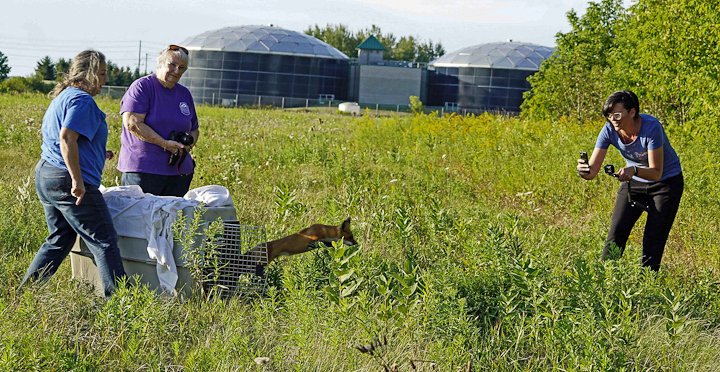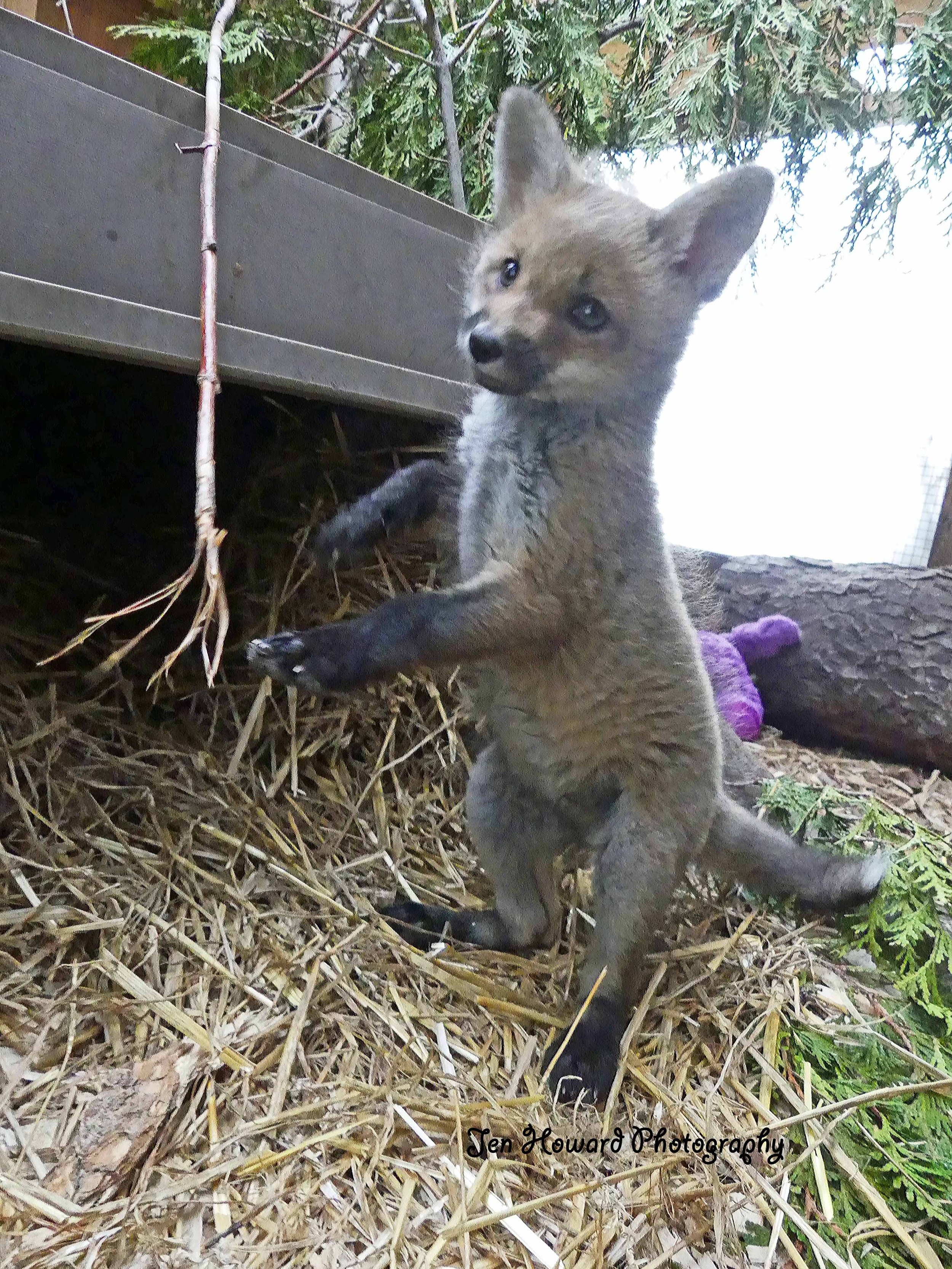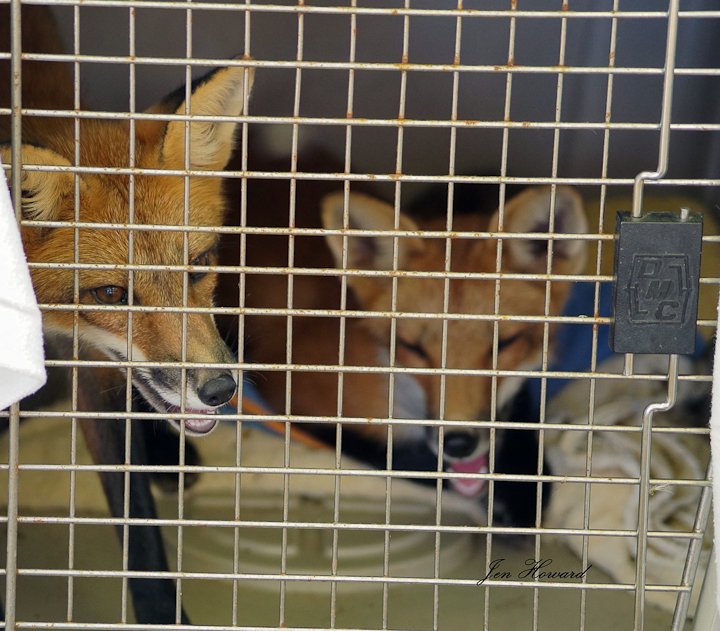Wildlife Rescue: The year of the Fox
All photos courtesy of Jennifer Howard
Is mange in foxes fatal or easily cured?
The year 2021 will be memorable for the wildlife workers at Procyon Wildlife Rehabilitation and Education Centre for one reason: Foxes and plenty of them.
The wildlife centre in Beeton Ontario north of Toronto was inundated with red foxes in need of help.
Most of the foxes that were rescued by centre staff suffered from mange, but a few were admitted for head trauma resulting from collisions with vehicles. All of the foxes were saved and most have been released. Depending on the severity of the mange, and how early it was caught, curing the animal can be relatively easy with proper administration of medication. However, if left untreated foxes will die from mange.
“In years past we would maybe get two, up to maybe five foxes in the wildlife centre,” explains Jennifer Howard, a volunteer rescuer and rehabilitator at the centre.
“At the moment we have four foxes in our care and, I believe, this is the most we have had in at one time,” Howard explained at the time this article was put together in late fall. “Usually it works out that one is ready to go when a new one comes in. It was almost like an assembly line of foxes coming and going. it was pretty crazy!”
“However in 2021 it was an extremely bad year for mange, Howard explains. In Innisfil (a small village in rural Ontario) alone I got 19 foxes all with mange in various stages. Plus we got a couple car collisions from other areas and other cases of mange from other areas. All total I believe about 28 red foxes were admitted last year.”
Some of those foxes celebrated New Years at the facility and were still getting treatment into january 2022.
And the situation does not appear to be letting up. Already, the wildlife centre has admitted its first fox of the year on January 6 with mange.
For more on the work wildlife rescue and rehabilitators perform, be sure to take a look at my entertaining and informative article about Angels For Wildlife.
This fox shows advanced mange illustrated by bare patches and crusty, scabs on the skin.
For those who may not know about Sarcoptic Mange, sometimes called canine scabies, it is a type of skin disease, caused by parasitic mites. The mites that cause mange in mammals embed themselves by burrowing into the animals’ skin or hair follicles.
If left untreated, mange will cause the animal intense itching from an allergic reaction to the mites’ feces. Severe crusting develops on the animal’s skin that often becomes infected. The combination of infection, crusting (often around the eyes) and hair loss can progress until the fox is unable to care for itself or hunt, and it loses the insulation from its fur resulting in a slow and painful death.
If you see or have foxes in your garden, check out this article on the Fox Den in your garden and helping fox with mange.
The good news is that, if the animal is rescued in time, treatment is simple enough that they can be returned to the wild in most cases in a few short weeks. Secondary problems that may or may not be related to the illness can be more difficult to treat and result in a longer stay at the wildlife center.
Ever heard a fox scream. It’s terrifying but fascinating. For more on why foxes scream, check out my post here.
(More on the identification and treatment of mange in foxes is spelled out in this earlier article in Ferns & Feathers about recognizing mange in foxes living in, or using your woodland/wildlife garden.)
The good news is that all the foxes at Procyon Wildlife Centre are doing well and are either already set free or are on the road back to freedom.
“Some of those foxes had other issues, sores on their rump, minor injuries on a leg or foot, or were severely emaciated. But mange was the dominating issue,” Howard explains.
Many of the foxes admitted last year were kits, but thankfully, they were old enough so no special treatment was needed in their care.
But, a few years back, there was a special, very young little fox that was found alone in the snow with its eyes still closed.
“She was found in the snow with some fur from the den around her. No one knew how she got there,” explains Howard.
The tiny fox “was hypothermic, hungry, dehydrated and in critical condition” when they rescued her.
One of Procyon’s board of directors and animal caregivers took her home for round-the-clock care. Residents in the area even “donated fur coats to us so we could swaddle the tiny fox in fur (just like she would have received from her mother).” A soft stuffed toy was added for her to cuddle.
“She was adorable. She came back and forth on the days her caregiver came in only after she was stable. She became more curious day by day and was handled by only her caregiver at that time,” explains Howard.
Her story, as told by her caregiver Sarah Marrs Bruce, is one staff won’t soon forget.
Talitha, a tiny rescued kit, needed round-the-clock care until it got old enough to begin eating on its own.
Meet Talitha: Procyon’s youngest and tiniest fox kit ever
When Talitha arrived, she had been called in as a baby raccoon.
This, most likely, was because her fur was still in the grey phase and not showing any of the typical red fox colouring yet. The colouring can take a few weeks to grow in, in the meantime serving as a part of the kit’s protection against predators – helping them blend into their dens.
She was still eyes-closed and estimated to be approximately 7-10 days old.
Staff used stuffed animals to keep Talitha comforted when she was alone.
She had been found in a snowbank surrounded by torn up fur that could have been from litter mates or her mother. It took a couple days to get her stabilized – warmed up and hydrated and able to handle diluted specialized formula.
She needed comfort but we needed to be very careful about not habituating her to humans. Once her eyes were open we provided her cuddle buddies that were stuffies (including one that had its own heartbeat). At the same time we blocked visual access to her caregiver (in an attempt to keep her as wild as possible.)
She progressed quite quickly from nursing on a “magic nipple” to eating a soft-porridge-like food made from a combination of species specific infant formula mixed with liquified kibble.
The images below show Talitha growing up with her buddy and her eventual release.




As soon as she could feed herself without assistance and was gaining weight reliably on her own, she was quickly moved into a larger outside enclosure to even further reduce her exposure to people. At that time we began searching throughout the province for another fox near her age that she could socialize with. Foxes are very social animals and it was essential to her development to be around other foxes to learn vocalizations and normal social behaviour with conspecifics.
“Caring for her was one of the highlights of my experiences as a volunteer and one that I won't ever forget. Her release together with another fox from the area was a joyful day for myself and several others.”
Work at the Centre never really ends
“After the baby stages, we are very careful to limit the handling of the animals to very few people, explains Howard, “Especially fawns, raccoons, foxes and coyotes, who are easily habituated to humans.”
Staff where gowns and masks and try not to speak in the presence of the animals. They only go out to feed and change the animal’s water at this point.
Rehabilitation Centres from other parts of the province work together to create the best environment for the animals to grow up knowing how to act and survive out in the wild.
“These species also need others of their kind, to bond with, play with, and learn from each other. That is of utmost importance so they do not get attached to their caregiver. We will search for others their age until we find one from other rehabilitation centres, then they either come to us or we go to them.”
In conclusion
The dedication and commitment shown by the volunteer staff at Procyon Wildlife Rehabilitation and Educational Centre is a testament to the type of people who have a special place in their hearts for our wild critters. This same dedication is to helping wildlife occurs everyday in rescue and wildlife refuges in the United States, Canada, the Europe, and throughout the world in countries big and small. Animals of all kinds, from the largest elephants to the tiniest creatures. As habitats are destroyed, either from natural calamities such as wildfires to the slow encroachment of urbanization, it is important for gardeners to do our part to recreate habitat in our yards for many of these creatures.
It is also falling to us to keep an eye on our backyard friends to ensure they are safe and free from illness. That includes everything from keeping our bird feeders and bird baths clean to stop the spread of disease, to taking immediate action if we see a sick or injured animal such as foxes suffering from mange in our woodland/wildlife gardens.
Take the time to look up your local wildlife refuge and make a donation. If you can donate your time or skills, I’m sure they would welcome it with open arms, if you cannot, a financial contribution to any one of these non-profit groups will go a long way to help them help our wild friends.
Ever wonder why foxes scream out in the night. Check out my story here.
The following are helpful Resources for homeowners looking for wildlife rescue and rehabilitation assistance
Worldwide
In Canada
https://www.nwrfcanada.org/what-we-do
http://www.ontariowildliferescue.ca/contact.php
https://www.ontario.ca/page/find-wildlife-rehabilitator
In the United States
• Here is an extensive state-by-state listing from the Humane Society of the United States on how to find a wildlife rehabilitator
https://www.humanesociety.org/resources/how-find-wildlife-rehabilitator
In the United Kingdom
https://www.rspca.org.uk/adviceandwelfare/wildlife/findarehabilitator
• The British Wildlife Rehabilitation Council includes a clickable download of UK rehabilitators
http://www.bwrc.org.uk/FindaRehabilitator
• Here is an extensive list of UK Animal Rescuers from Animal Rescuers.co.uk






